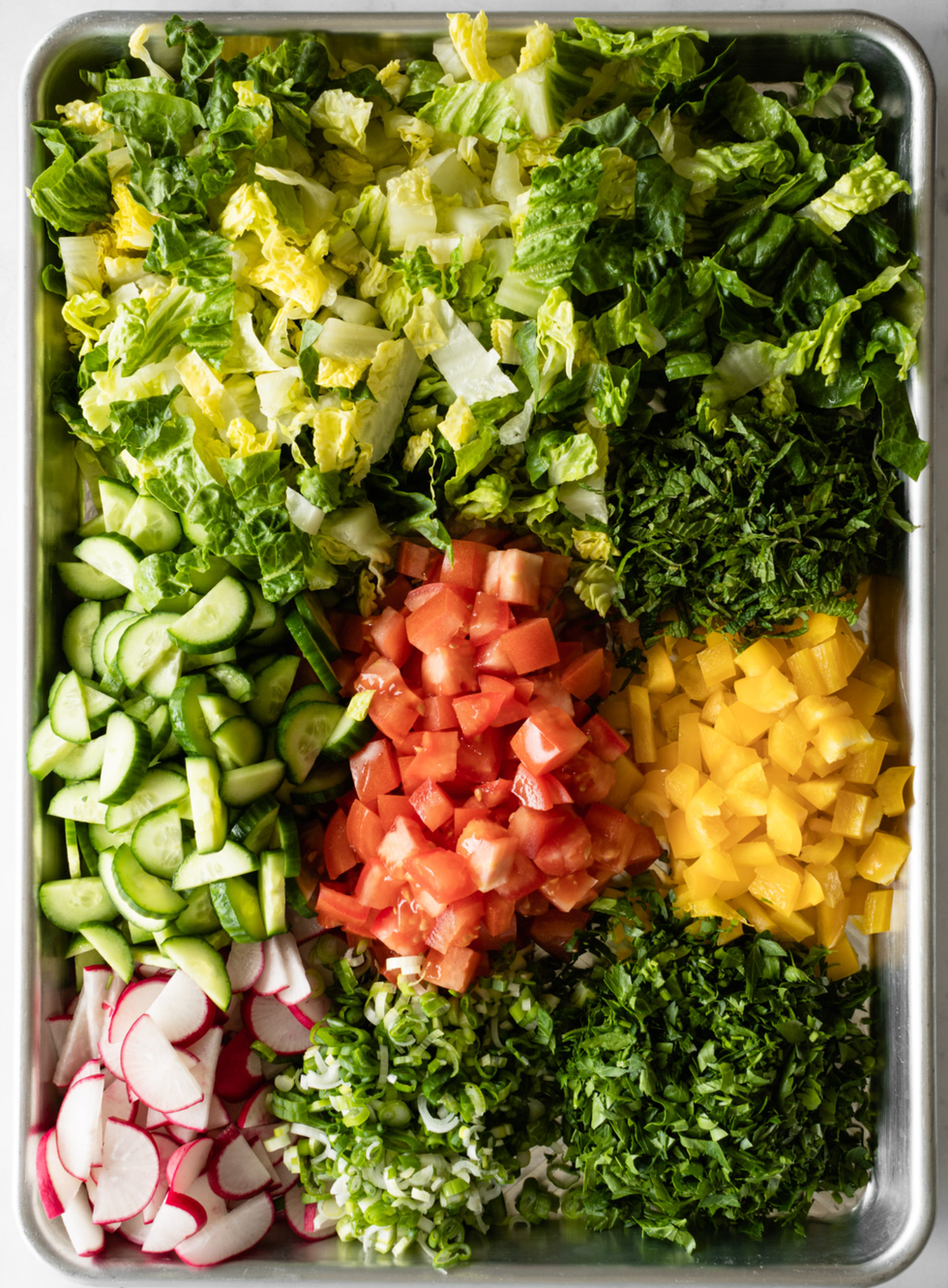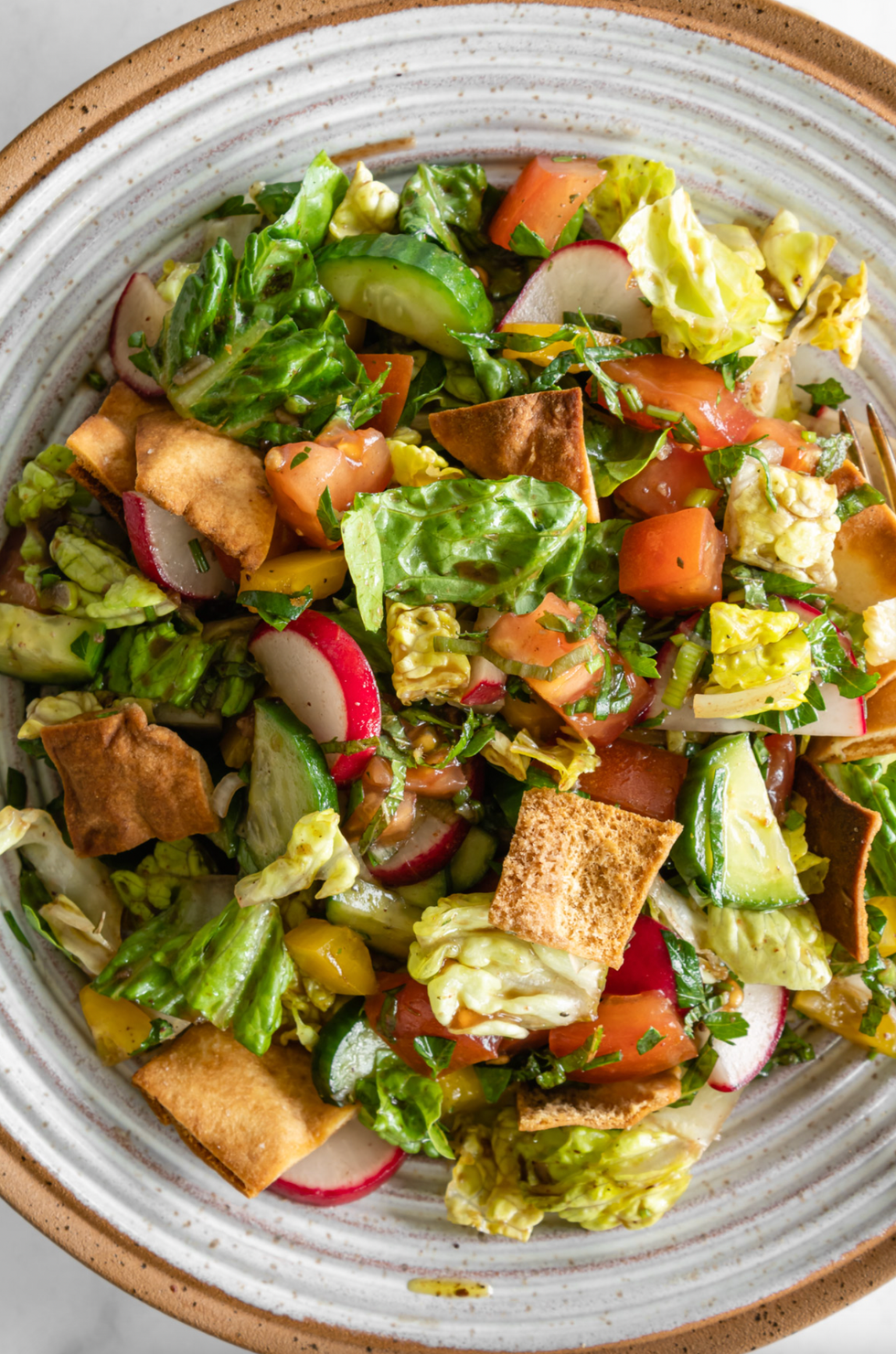Dig in to this delish dish.
This Authentic Fattoush Salad Is Perfect For A Healthy Summertime Lunch

Gladys is the recipe developer, food stylist, and food photographer behind her blog, Forks and Foliage. You'll find her sharing authentic Lebanese dishes as well as recipes inspired by her love for Mediterranean flavors. Follow Gladys along on her blog and social media accounts for wholesome, seasonal recipes with the occasional indulgence.
Gladys Soriano is the recipe developer, food stylist, and food photographer behind the Mediterranean-inspired blog Forks and Foliage. Here, she's sharing authentic Lebanese dishes and recipes inspired by her love for Mediterranean flavors (originally published on Forks and Foliage). Take it away, Gladys!
This authentic fattoush salad recipe is what summer is all about! A combination of summer's best produce is tossed with a mouthwateringly delicious dressing and crunchy homemade pita chips for the ultimate bread salad. Keep reading to learn how to make the best fattoush you'll ever have! Be warned: you'll want to drink the dressing straight!
Fattoush is a traditional bread salad that originated in Northern Lebanon. The word fattoush comes from the Arabic word "fatt" which means to break up into small pieces or crumbs. Basically, Lebanese farmers used to fry up leftovers scraps of pita bread and toss them with whatever vegetables and herbs were in season. And now fattoush is one of the most loved salads in the Middle East and around the world!
The best time to make fattoush salad is in the summer when produce is in peak season. Sourcing the best produce has a huge bearing on how good your fattoush turns out.
Fattoush Salad Ingredients

Salad
- 1 head romaine lettuce, chopped
- 1 cup purslane leaves, stems removed
- 3 Persian cucumbers, sliced into half moons
- 3 tomatoes, diced
- 4 radishes, sliced into half moons
- 1 bell pepper, any color, diced
- 3 green onions, thinly sliced (both white and green parts)
- 1 cup fresh mint, chopped
- 1 cup flat-leaf parsley, chopped
Dressing
- ⅓ cup extra virgin olive oil
- ¼ cup fresh lemon juice
- 2 tablespoons pomegranate molasses
- 1 garlic clove, grated or minced
- 2 teaspoons sumac
- 1 teaspoon dried mint
- 2 teaspoons kosher salt, adjust to taste
Pita Chips
- 2 loaves thin pita bread
- 1 tablespoon olive oil
- ¼ teaspoon kosher salt
Fattoush Salad Recipe Instructions

- Preheat the oven to 400°F. Brush both sides of the pita bread with olive oil and sprinkle with salt. Cut them into one inch squares and spread on a baking sheet. Bake them for 8 to 10 minutes, or until they are golden brown and crunchy. Set aside. (Traditionally, pita bread is fried for fattoush salad. You can do that if you want to, but in this recipe I'm showing you the healthier, easier, and quicker option which is to toast them in the oven.)
- In the meantime, chop all the vegetables and herbs and place them in a large bowl. How small or large you chop everything is entirely up to personal preference.
- In a small bowl, combine the olive oil, lemon juice, pomegranate molasses, garlic, sumac, dried mint, and salt. Mix thoroughly and set aside.
- A few minutes before serving, toss the salad with the dressing until fully coated. Taste it and adjust the salt as needed. I do recommend tossing the veggies with the dressing at least 15 minutes before serving because it allows everything to marinate in the delicious dressing.
- At the last minute, toss the pita chips into the salad and serve. Alternatively, leave the pita chips on the side and let each person add it to their salad plate to prevent soggy pita chips.

SUBSTITUTIONS AND VARIATIONS
This recipe is naturally vegan and dairy-free. I highly recommend following this recipe as is for the most delicious and authentic fattoush salad.
- Gluten-free: Simply omit the pita chips or look for gluten-free pita bread.
- Vegetables: Feel free to throw in any other seasonal produce that you enjoy.
- Pita chips: You could sprinkle sumac or za'atar on the pita bread before toasting if you want a little extra flavor on them.
- Protein: Fattoush salad makes for a light, vegetarian meal, but if you want you can top it with some grilled chicken or other meat. Alternatively, you could toss in some cooked chickpeas for plant-based protein, which I actually really enjoy in it.
TIPS ON MAKING THE BEST AUTHENTIC FATTOUSH SALAD
- Buy the highest quality ingredients you can afford. Farmers markets are a great place to get the best and freshest produce that's in season. If the vegetable doesn't taste good on its own, your fattoush will not taste its best. Same goes for the olive oil and everything else in this recipe.
- Don't use store-bought pita chips. The extra step to make your own pita chips at home is well worth it, trust me.
- Buy the thinnest pita bread you can find. Lebanese pita bread is much much thinner than most pita bread sold in regular grocery stores in the US. Avoid the thick and fluffy pita pockets. Authentic fattoush is made with very thin and crispy pita chips.
- Don't skip the pomegranate molasses and sumac. The salad will still taste great without them, but it won't taste nearly as amazing as using them. These two traditional ingredients give fattoush it's signature flavor.
- Season generously. Often times the difference between an okay salad and an amazing salad is how well it's salted. Salt brings out the delicious flavors in the vegetables, herbs, and the dressing. So if you taste it and there's no party in your mouth, add more salt.
- You can prepare the different components of fattoush salad several days in advance, and toss everything together just before serving.
- All the ingredients can easily be found at your local Middle Eastern market and maybe even in the ethnic aisles at regular grocery stores.
- Fattoush salad is best enjoyed immediately because the vegetables and pita chips get soggy after a while. Store any leftovers in an airtight container in the fridge and consume the next day.
Love this Lebanese fattoush salad recipe and want to get our latest foodie finds straight to your inbox? Subscribe to our newsletter!



















